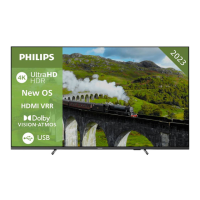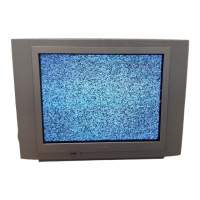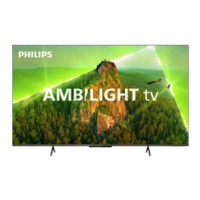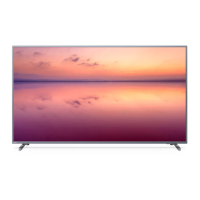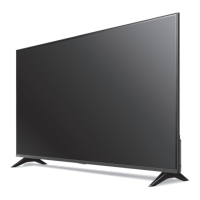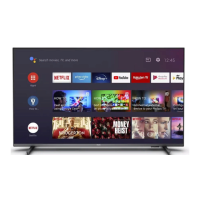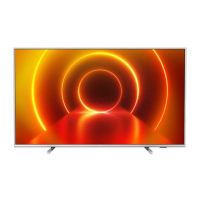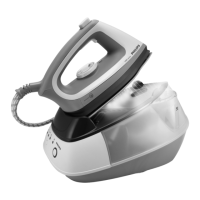Do you have a question about the Philips 7600 series and is the answer not in the manual?
Explains the TV's high resolution and pixel count for detailed picture quality.
Describes smart TV features, apps, and mobile connectivity.
Guides on accessing and utilizing applications on the TV.
Details how to use the TV as a gaming platform.
Information on renting movies and accessing on-demand content.
Explains how to pause live TV and record broadcasts using a USB drive.
Introduction to the TV's 3D capabilities.
Description of the Ambilight feature for enhanced viewing.
How to extend Ambilight effect with Philips Hue bulbs.
Emphasizes reading safety instructions before operating the TV.
Instructions for installing the TV stand or mounting it on a wall.
Guidance on optimal TV placement for viewing comfort and Ambilight effect.
Instructions on connecting and handling the TV's power cable safely.
How to connect the antenna cable for receiving TV signals.
Information on connecting and setting up a satellite dish for TV reception.
Importance of connecting the TV to the internet for smart features.
Step-by-step guide for establishing wired or wireless network connections.
How to view and configure network settings, including static IP.
How to access media files shared from computers or NAS.
General advice on using the best quality connections for optimal audio and video.
How to use a CI+ CAM module for accessing premium channels.
Instructions for connecting external receivers like cable boxes.
Details on connecting audio systems via HDMI or optical cables.
How to connect a Blu-ray player using HDMI and EasyLink features.
Instructions for connecting a DVD player via HDMI or SCART.
How to connect headphones and adjust their volume.
Guidance on connecting game consoles using HDMI for optimal gaming.
Connecting wireless gamepads for internet gaming on the TV.
Requirements and setup for using USB hard drives for pausing and recording TV.
How to connect and use USB flash drives for media playback.
Connecting digital cameras to view photos on the TV.
Connecting camcorders to the TV for video playback.
Connecting a computer to use the TV as a PC monitor.
Basic operations for turning the TV on and putting it into standby mode.
How to adjust or turn off the brightness of the Philips logo on the TV.
Using the TV's physical buttons for basic operations when the remote is unavailable.
Setting the TV to automatically switch to standby after a specified period.
Deactivating the automatic TV switch-off feature for energy saving.
Identifies and describes the functions of all buttons on the remote control.
Details on using the QWERTY/Azerty/Cyrillic keyboard on the remote for text input.
Information on pairing the remote control with the TV using radio frequency.
Instructions for replacing the remote control batteries.
Guidelines for cleaning the remote control properly.
How to navigate and access items within the TV's Home menu.
Information on managing and viewing installed TV and radio channels.
How to tune into channels, switch between them, and view program information.
Instructions on locking channels and setting up parental controls.
Setting age-based restrictions for viewing programs.
Accessing and adjusting settings like subtitles and audio languages for channels.
Setting preferred languages for audio tracks on digital channels.
Creating, renaming, removing, and reordering lists of favorite channels.
How to view program schedules and information for installed channels.
Accessing and navigating Teletext pages for additional information.
Understanding and using interactive TV services offered by broadcasters.
Introduction to personalized TV recommendations and online services.
Viewing recommendations for currently airing or upcoming popular programs.
Accessing missed programs or catch-up TV services.
Renting movies from an online video store.
How to select and view content from connected external devices.
Automatic detection and assignment of device types and icons.
Using the remote to turn on connected devices and start playback instantly.
Overview of the TV's application ecosystem, including pre-installed and downloadable apps.
Steps to download and install applications from the Philips App Gallery or Google Play.
How to launch and stop applications on the TV.
Viewing media files directly from connected USB storage devices.
Accessing media files shared from computers or Network Attached Storage.
Requirements for watching 3D content, including compatible glasses.
Overview, operation, and battery replacement for the 3D glasses.
Configuring automatic 3D switching and 2D to 3D conversion.
Recommendations for the best 3D viewing experience.
Guidelines for cleaning and maintaining 3D glasses.
Important health precautions related to 3D viewing.
Watching TV channels in a small screen while viewing Teletext.
Watching TV channels alongside an app in the App Gallery.
Watching TV channels while viewing content from an HDMI device.
Adjusting picture settings like style, colour, contrast, and sharpness.
Configuring sound styles, bass, treble, surround modes, and audio outputs.
Customizing Ambilight effects, brightness, saturation, and wall colour settings.
Managing power-saving features like energy saving, screen off, and light sensor.
Adjusting general TV settings including EasyLink, HDMI Ultra HD, and Android settings.
Setting the TV's clock, region, and menu language preferences.
Enabling features for users with hearing or visual impairments.
Connecting the TV to networks and managing Bluetooth devices.
Accessing and adjusting settings for Android applications.
Setting up and updating channels received via antenna or cable.
Installing channels from satellite dishes, including Unicable and MDU setups.
Instructions for updating the TV's software via USB or the internet.
How to check the currently installed TV software version.
Information about the open-source software used in the TV.
Details on the licenses governing the open-source software components.
Receiving notifications about software updates and related issues.
Information on the TV's energy efficiency and disposal guidelines.
Technical specifications related to the TV's power requirements and features.
Technical specifications for TV signal reception.
Information about the screen size, resolution, and supported video formats.
Physical dimensions and weight of the TV with and without stand.
List of all available ports and connection types for the TV.
Audio specifications, including sound technologies and output power.
Supported file formats for video, audio, subtitles, and image codecs.
Information on how to register the TV for benefits and support.
Common issues and solutions for channels, picture, sound, and connections.
On-screen help features and how to access them.
How to find support and FAQs on the Philips website.
Information on contacting customer care for support and repair.
Important safety instructions and warnings for using the TV.
Guidelines for cleaning and maintaining the TV screen to prevent damage.
Copyright information related to Ultra HD technology.
Trademark and licensing information for HDMI technology.
Copyright and trademark information for Dolby Digital Plus.
Patent and trademark information for DTS Premium Sound.
Trademark information for DLNA certification.
Trademark information for Windows Media and PlayReady.
Trademark information for Wi-Fi Alliance.
Trademark information for Kensington security products.
General statement about other trademarks.
Explains the TV's high resolution and pixel count for detailed picture quality.
Describes smart TV features, apps, and mobile connectivity.
Guides on accessing and utilizing applications on the TV.
Details how to use the TV as a gaming platform.
Information on renting movies and accessing on-demand content.
Explains how to pause live TV and record broadcasts using a USB drive.
Introduction to the TV's 3D capabilities.
Description of the Ambilight feature for enhanced viewing.
How to extend Ambilight effect with Philips Hue bulbs.
Emphasizes reading safety instructions before operating the TV.
Instructions for installing the TV stand or mounting it on a wall.
Guidance on optimal TV placement for viewing comfort and Ambilight effect.
Instructions on connecting and handling the TV's power cable safely.
How to connect the antenna cable for receiving TV signals.
Information on connecting and setting up a satellite dish for TV reception.
Importance of connecting the TV to the internet for smart features.
Step-by-step guide for establishing wired or wireless network connections.
How to view and configure network settings, including static IP.
How to access media files shared from computers or NAS.
General advice on using the best quality connections for optimal audio and video.
How to use a CI+ CAM module for accessing premium channels.
Instructions for connecting external receivers like cable boxes.
Details on connecting audio systems via HDMI or optical cables.
How to connect a Blu-ray player using HDMI and EasyLink features.
Instructions for connecting a DVD player via HDMI or SCART.
How to connect headphones and adjust their volume.
Guidance on connecting game consoles using HDMI for optimal gaming.
Connecting wireless gamepads for internet gaming on the TV.
Requirements and setup for using USB hard drives for pausing and recording TV.
How to connect and use USB flash drives for media playback.
Connecting digital cameras to view photos on the TV.
Connecting camcorders to the TV for video playback.
Connecting a computer to use the TV as a PC monitor.
Basic operations for turning the TV on and putting it into standby mode.
How to adjust or turn off the brightness of the Philips logo on the TV.
Using the TV's physical buttons for basic operations when the remote is unavailable.
Setting the TV to automatically switch to standby after a specified period.
Deactivating the automatic TV switch-off feature for energy saving.
Identifies and describes the functions of all buttons on the remote control.
Details on using the QWERTY/Azerty/Cyrillic keyboard on the remote for text input.
Information on pairing the remote control with the TV using radio frequency.
Instructions for replacing the remote control batteries.
Guidelines for cleaning the remote control properly.
How to navigate and access items within the TV's Home menu.
Information on managing and viewing installed TV and radio channels.
How to tune into channels, switch between them, and view program information.
Instructions on locking channels and setting up parental controls.
Setting age-based restrictions for viewing programs.
Accessing and adjusting settings like subtitles and audio languages for channels.
Setting preferred languages for audio tracks on digital channels.
Creating, renaming, removing, and reordering lists of favorite channels.
How to view program schedules and information for installed channels.
Accessing and navigating Teletext pages for additional information.
Understanding and using interactive TV services offered by broadcasters.
Introduction to personalized TV recommendations and online services.
Viewing recommendations for currently airing or upcoming popular programs.
Accessing missed programs or catch-up TV services.
Renting movies from an online video store.
How to select and view content from connected external devices.
Automatic detection and assignment of device types and icons.
Using the remote to turn on connected devices and start playback instantly.
Overview of the TV's application ecosystem, including pre-installed and downloadable apps.
Steps to download and install applications from the Philips App Gallery or Google Play.
How to launch and stop applications on the TV.
Viewing media files directly from connected USB storage devices.
Accessing media files shared from computers or Network Attached Storage.
Requirements for watching 3D content, including compatible glasses.
Overview, operation, and battery replacement for the 3D glasses.
Configuring automatic 3D switching and 2D to 3D conversion.
Recommendations for the best 3D viewing experience.
Guidelines for cleaning and maintaining 3D glasses.
Important health precautions related to 3D viewing.
Watching TV channels in a small screen while viewing Teletext.
Watching TV channels alongside an app in the App Gallery.
Watching TV channels while viewing content from an HDMI device.
Adjusting picture settings like style, colour, contrast, and sharpness.
Configuring sound styles, bass, treble, surround modes, and audio outputs.
Customizing Ambilight effects, brightness, saturation, and wall colour settings.
Managing power-saving features like energy saving, screen off, and light sensor.
Adjusting general TV settings including EasyLink, HDMI Ultra HD, and Android settings.
Setting the TV's clock, region, and menu language preferences.
Enabling features for users with hearing or visual impairments.
Connecting the TV to networks and managing Bluetooth devices.
Accessing and adjusting settings for Android applications.
Setting up and updating channels received via antenna or cable.
Installing channels from satellite dishes, including Unicable and MDU setups.
Instructions for updating the TV's software via USB or the internet.
How to check the currently installed TV software version.
Information about the open-source software used in the TV.
Details on the licenses governing the open-source software components.
Receiving notifications about software updates and related issues.
Information on the TV's energy efficiency and disposal guidelines.
Technical specifications related to the TV's power requirements and features.
Technical specifications for TV signal reception.
Information about the screen size, resolution, and supported video formats.
Physical dimensions and weight of the TV with and without stand.
List of all available ports and connection types for the TV.
Audio specifications, including sound technologies and output power.
Supported file formats for video, audio, subtitles, and image codecs.
Information on how to register the TV for benefits and support.
Common issues and solutions for channels, picture, sound, and connections.
On-screen help features and how to access them.
How to find support and FAQs on the Philips website.
Information on contacting customer care for support and repair.
Important safety instructions and warnings for using the TV.
Guidelines for cleaning and maintaining the TV screen to prevent damage.
Copyright information related to Ultra HD technology.
Trademark and licensing information for HDMI technology.
Copyright and trademark information for Dolby Digital Plus.
Patent and trademark information for DTS Premium Sound.
Trademark information for DLNA certification.
Trademark information for Windows Media and PlayReady.
Trademark information for Wi-Fi Alliance.
Trademark information for Kensington security products.
General statement about other trademarks.
| Display Type | LED |
|---|---|
| Smart TV | Yes |
| Operating System | Android TV |
| Refresh Rate | 60 Hz |
| HDMI Ports | 4 |
| USB Ports | 2 |
| Dimensions (Without Stand) | Varies by screen size |
| Weight (Without Stand) | Varies by screen size |
| Resolution | 4K Ultra HD (3840 x 2160) |
| Screen Size | 43", 50", 55", 65", 75" |
| Voice Control | Yes (Google Assistant) |
| Wi-Fi | Yes (802.11ac) |
| Bluetooth | Yes |
| Sound Output | 20W |

